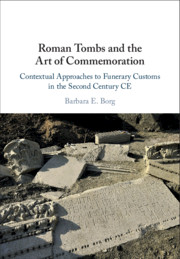Refine search
Actions for selected content:
23990 results in Ancient history
Chapter 10 - Polis and Island Histories and the Late Classical and Hellenistic World: A New Hellenism?
-
- Book:
- Polis Histories, Collective Memories and the Greek World
- Published online:
- 26 March 2019
- Print publication:
- 11 April 2019, pp 386-409
-
- Chapter
- Export citation
Chapter 7 - Polis in Flux: Dislocation and Disenfranchisement in Samos
-
- Book:
- Polis Histories, Collective Memories and the Greek World
- Published online:
- 26 March 2019
- Print publication:
- 11 April 2019, pp 275-315
-
- Chapter
- Export citation
Appendix 3 - Register of Polis, Island and Ethnos Histories: Jacoby’s Local Histories
-
- Book:
- Polis Histories, Collective Memories and the Greek World
- Published online:
- 26 March 2019
- Print publication:
- 11 April 2019, pp 417-445
-
- Chapter
- Export citation
Index Locorum
-
- Book:
- Polis Histories, Collective Memories and the Greek World
- Published online:
- 26 March 2019
- Print publication:
- 11 April 2019, pp 475-479
-
- Chapter
- Export citation
Chapter 9 - The Aristotelian Politeiai and Local Histories
-
- Book:
- Polis Histories, Collective Memories and the Greek World
- Published online:
- 26 March 2019
- Print publication:
- 11 April 2019, pp 358-385
-
- Chapter
- Export citation
Note on References and Abbreviations
-
- Book:
- Polis Histories, Collective Memories and the Greek World
- Published online:
- 26 March 2019
- Print publication:
- 11 April 2019, pp x-xii
-
- Chapter
- Export citation
Chapter 5 - Origins, Foundations and Ethnicity: Greeks and Non-Greeks
-
- Book:
- Polis Histories, Collective Memories and the Greek World
- Published online:
- 26 March 2019
- Print publication:
- 11 April 2019, pp 177-226
-
- Chapter
- Export citation
Copyright page
-
- Book:
- Polis Histories, Collective Memories and the Greek World
- Published online:
- 26 March 2019
- Print publication:
- 11 April 2019, pp iv-iv
-
- Chapter
- Export citation
Chapter 2 - Tales for the Telling: τὸ μυθῶδες
-
- Book:
- Polis Histories, Collective Memories and the Greek World
- Published online:
- 26 March 2019
- Print publication:
- 11 April 2019, pp 74-99
-
- Chapter
- Export citation

Dreams, Virtue and Divine Knowledge in Early Christian Egypt
-
- Published online:
- 08 April 2019
- Print publication:
- 25 April 2019

Roman Tombs and the Art of Commemoration
- Contextual Approaches to Funerary Customs in the Second Century CE
-
- Published online:
- 01 April 2019
- Print publication:
- 18 April 2019
Index
-
- Book:
- Population and Economy in Classical Athens
- Published online:
- 08 March 2019
- Print publication:
- 28 March 2019, pp 268-272
-
- Chapter
- Export citation
Chapter 7 - Beyond Food and Fuel
-
- Book:
- Population and Economy in Classical Athens
- Published online:
- 08 March 2019
- Print publication:
- 28 March 2019, pp 205-243
-
- Chapter
- Export citation
Dedication
-
- Book:
- More Sayings of the Desert Fathers
- Print publication:
- 28 March 2019, pp v-vi
-
- Chapter
- Export citation
Contents
-
- Book:
- Population and Economy in Classical Athens
- Published online:
- 08 March 2019
- Print publication:
- 28 March 2019, pp vii-vii
-
- Chapter
- Export citation
Tables
-
- Book:
- Population and Economy in Classical Athens
- Published online:
- 08 March 2019
- Print publication:
- 28 March 2019, pp viii-viii
-
- Chapter
- Export citation
Chapter 5 - Population Changes
-
- Book:
- Population and Economy in Classical Athens
- Published online:
- 08 March 2019
- Print publication:
- 28 March 2019, pp 139-170
-
- Chapter
- Export citation
Copyright page
-
- Book:
- Population and Economy in Classical Athens
- Published online:
- 08 March 2019
- Print publication:
- 28 March 2019, pp vi-vi
-
- Chapter
- Export citation
Chapter 6 - Sayings Preserved in Coptic
-
- Book:
- More Sayings of the Desert Fathers
- Print publication:
- 28 March 2019, pp 118-145
-
- Chapter
- Export citation
Preface
-
- Book:
- More Sayings of the Desert Fathers
- Print publication:
- 28 March 2019, pp xiii-xx
-
- Chapter
- Export citation
